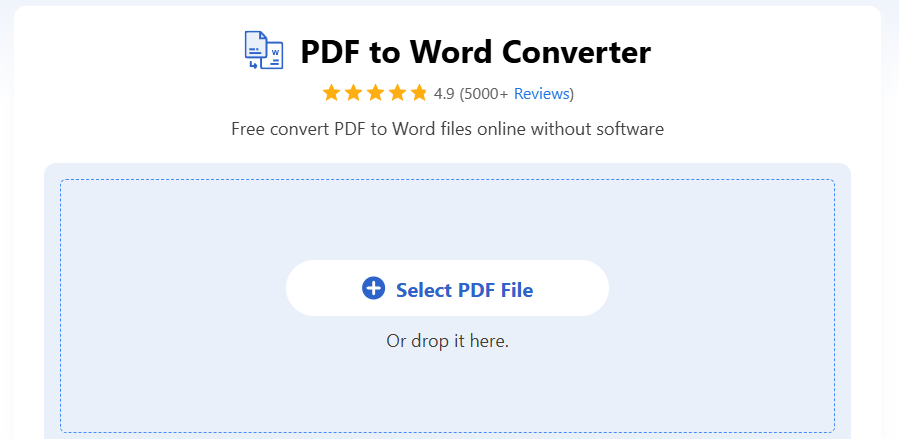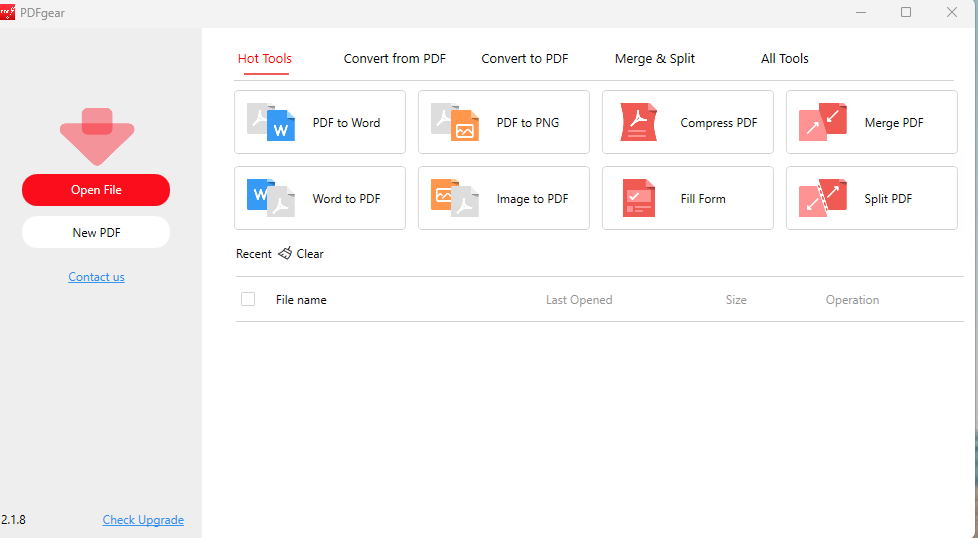Table of Contents
Google Docs is an excellent platform for collaboration, editing, and cloud-based storage. It does allow you to open and edit .pdf files – but usually with notable formatting issues. If you’ve ever uploaded a PDF to Google Docs, you’ve probably noticed the formatting goes haywire — fonts change, images shift, tables break, and page layouts collapse.
In this guide, we’ll introduce the steps to upload PDFs to Google Docs, explore why formatting breaks, and explain how PDFgear offers the best solution for preserving your document’s layout.
The Native Way: How to Upload and Convert PDF to Google Docs
There’s no option for you to directly open a PDF in Google Docs. To achieve this, you’ll need to upload your PDF to your Google Drive, and open it in Google Docs from there. Then Google Drive will automatically convert the PDF to a Google Docs format, which you can then edit.
Here’s how:
1. Open Google Drive in your web browser.
2. In the top-left corner, click the “+ New” button, then “File upload”, and select the file from your computer.
3. Locate the uploaded PDF in your Google Drive, and right-click on the PDF file.
4. Hover over “Open with” and select “Google Docs”. Wait a bit, and the PDF will open as a Google Doc, and you can now view and edit the content.

Open PDF with the Google Docs
However, in most cases, this workflow will bring about formatting issues like shifted fonts, missing images, broken tables, and the overall layout will fall apart. That’s because Google Docs was never designed to handle PDF formatting with precision.
Now read on to learn why it happens, and how to fix that.

Example of Formatting Issues
Why Formatting Breaks When Opening PDF in Google Docs?
Google Docs is primarily a text-based collaboration platform, not a full-fledged PDF editor. When you try to import a PDF into Docs, the conversion engine attempts to reinterpret the static layout of a PDF into an editable text document. That’s where the problems begin. Let’s break down the most common issues depending on the method you use:
1. Uploading a PDF to Google Drive and Opening with Google Docs
This is the most common method, but it often produces disappointing results:
-
Fonts and Text Styles Don’t Match: PDFs preserve fonts as embedded objects. If Google Docs doesn’t support the exact font or style, it substitutes a generic font, causing shifts in character spacing, line breaks, and overall layout.
-
Tables and Columns Break Apart: Multi-column PDFs, tables with merged cells, or nested tables often turn into plain text or scrambled blocks. Complex tabular data may lose its borders and alignment entirely.
-
Headers, Footers, and Page Numbers Vanish: Since Google Docs focuses on continuous-flow documents, elements like headers, footers, and footnotes may be dropped during conversion.
-
Images Move Out of Place: Graphics embedded in PDFs rarely stay anchored to the same location. They often shift above or below related text, leaving the document visually inconsistent.
-
Vector Graphics and Charts Become Bitmaps: Instead of staying as editable vector objects, charts or diagrams can turn into low-resolution images, losing sharpness and editability.
2. Opening the PDF in Microsoft Word First, Then Uploading to Google Docs
Some tech-savvy users may go with this two-step workaround, it seems like a fix, but it doubles the risk of formatting loss:
-
Two Conversions Instead of One: First, Word attempts to interpret the PDF. Then, Google Docs attempts to interpret Word’s conversion. Each step increases distortions in formatting.
-
Spacing and Indentation Issues: Paragraph spacing, bullet points, and indentation often change when a PDF is converted in Word, and the issues amplify once imported into Docs.
-
Mismatched Page Layouts: Word may reconstruct the PDF’s layout differently from how Docs renders Word files, causing further inconsistencies.
In the techinical level, that happens because PDFs are fixed-layout documents. They’re designed for consistent display across devices, not for reflowing into editable formats. Every character, line, and image is positioned by coordinates on a page.
Google Docs works more like a word processor, where text flows freely from line to line. Converting a coordinate-based layout into a flow-based one is inherently error-prone. Unless the fonts in the PDF are natively supported in Docs, substitutions occur. Even small changes in kerning (space between characters) can cause whole paragraphs to shift. Elements like columns, footnotes, or tables inside PDFs have no one-to-one equivalent in Docs’ simplified structure.
In short, the more complex your PDF’s design, the more formatting breaks you’ll encounter when using Google Docs’ default or indirect conversion methods.
The Better Way: Convert PDF to Word with PDFgear (with Formatting Intact)
Looking for the most reliable way to convert PDF to Google Docs without losing formatting? PDFgear is your ultimate solution. With PDFgear, you can easily convert your PDFs into Word documents, which are fully compatible with Google Docs and can be uploaded directly in just a few clicks. This intermediate step ensures that the document’s structure is preserved before it’s introduced to the Google Docs environment.
Unlike other converters that compromise layout, fonts, or images, PDFgear features high-precision content extraction and ensures that every element of your file remains perfectly intact.
Step 1: Convert PDF to Word with PDFgear
PDFgear offers two excellent tools for this critical first step. Both are designed with advanced algorithms to accurately preserve the original document’s layout, fonts, and images.
PDFgear Online Converter: Our free web-based tool is a quick and easy solution for converting files without needing to download any software. We value your privacy, your files are processed in a secure connection and will be permanently deleted after the conversion.
1. Go to the PDFgear online PDF to Word converter.
2. Upload your PDF file.
3. Click “Convert” to process the file. The tool will generate a Word document (.docx) that retains the original formatting.
4. Download the converted Word file.

Convert PDF to Word with PDFgear Online Converter
PDFgear Desktop Software: For users who frequently work with large or complex documents, the desktop software provides a more powerful and reliable solution. It often handles large files more efficiently and may offer more advanced conversion options: it supports OCR for scanned/image-based PDFs and batch conversions.
1. Install and open the PDFgear software on your computer.
2. Select the “PDF to Word” conversion tool.
3. Choose your PDF files and enable OCR for scanned PDFs.
4. Click “Convert” to create the high-fidelity Word document.

Convert PDF to Word Offline
Step 2: Upload the Word Document to Google Docs
Once you have the accurately converted .docx file from PDFgear, the final step is to upload it to your Google Drive.
1. Open your Google Drive and click “+ New”.
2. Select “File upload”.
3. Choose the .docx file you converted with PDFgear.
4. Once the file is uploaded, right-click on it and select “Open with” > Google Docs.
By using this two-step process, you bypass the weaknesses of Google Drive’s native converter and leverage a specialized tool to ensure that tables, images, and complex layouts are meticulously transferred from the PDF to the Word document, resulting in a much cleaner, more editable file in Google Docs.

Open in Google Drive
Why PDFgear Preserves Formatting Better
Here’s why PDFgear stands out compared to Google Docs’ native PDF converter or Word’s built-in PDF import:
-
Direct Object Mapping: PDFgear maps each element of the PDF (text blocks, tables, images, vector graphics) directly to its equivalent object in Word. For example, a table in PDF stays as an actual Word table, instead of flattening into plain text.
-
Font Embedding and Substitution Handling: PDFgear extracts the font data embedded in the PDF and matches it with the closest Word-compatible fonts. This prevents the “random font substitution” issue common in Docs’ converter.
-
Preserves Coordinate-Based Layouts: Instead of reflowing the document, PDFgear reconstructs page layouts using Word’s advanced formatting features (margins, text boxes, sections). This ensures alignment, spacing, and multi-column designs remain intact.
-
High-Fidelity Image Handling: Graphics, charts, and logos are exported as high-resolution images or editable objects, so they don’t shift out of place when the Word file is opened in Docs.
-
Structural Accuracy for Complex PDFs: Footnotes, headers, and footers are preserved in their correct positions. Hyperlinks and bookmarks remain functional in the converted Word file.
PDFgear bridges the gap between fixed-layout PDFs and flow-based Google Docs by first creating a highly compatible Word version. Once you upload that Word file into Google Docs, the document stays clean, professional, and ready to collaborate on — without hours of manual fixes.
Final Expert Opinion
Google Docs’ native converter is fine for simple text extraction. For professional, academic, or high-stakes documents, PDFgear is the only solution that ensures formatting integrity. Stop wasting time with unreliable tools. Convert your PDFs confidently with PDFgear today.
-
Try the PDFgear Online PDF to Word Converter for instant conversions.
-
Download the PDFgear Desktop Software for offline, high-volume, professional-grade conversion.
